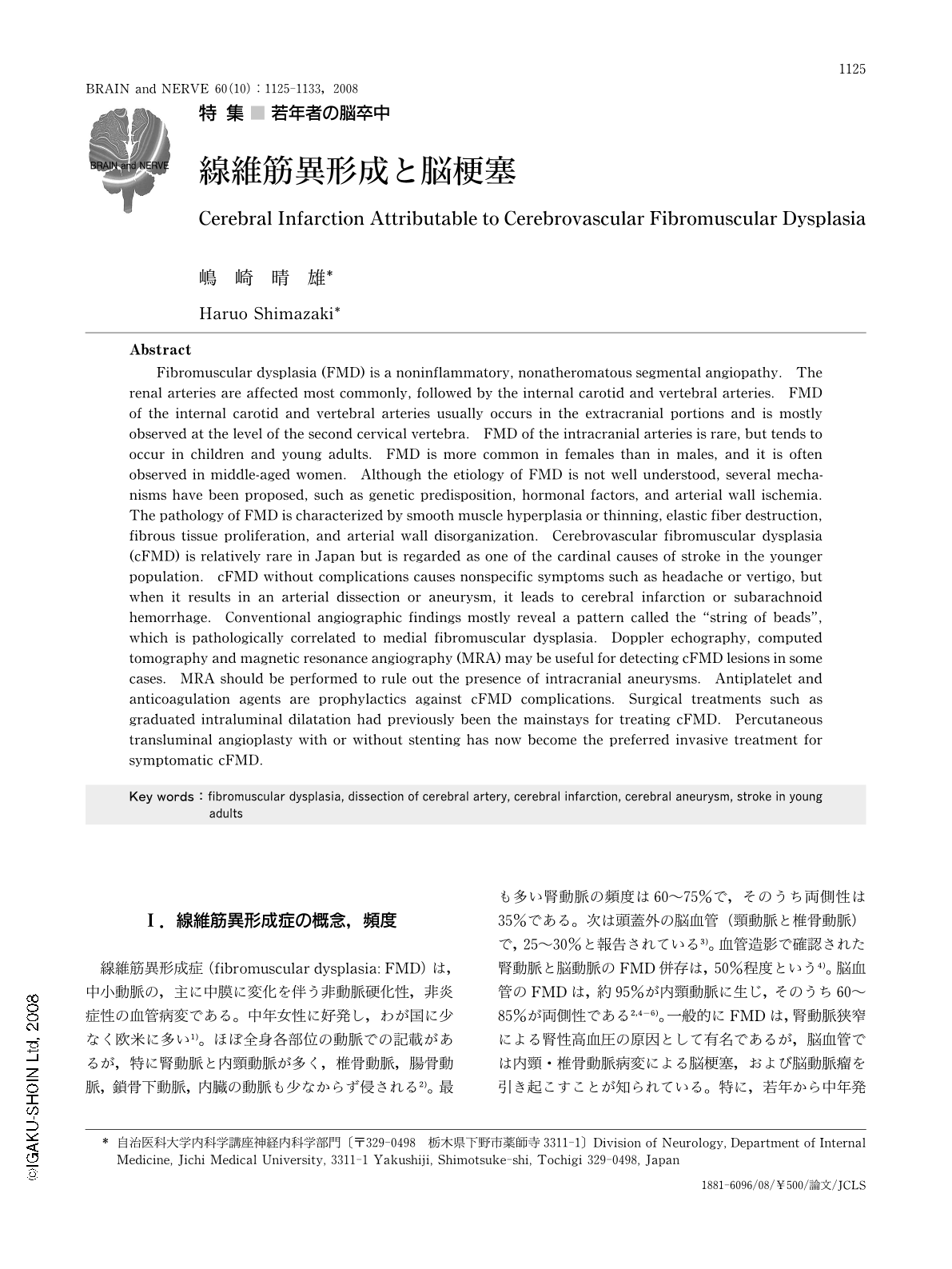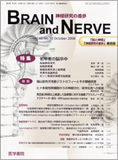Japanese
English
- 有料閲覧
- Abstract 文献概要
- 1ページ目 Look Inside
- 参考文献 Reference
Ⅰ.線維筋異形成症の概念,頻度
線維筋異形成症(fibromuscular dysplasia: FMD)は,中小動脈の,主に中膜に変化を伴う非動脈硬化性,非炎症性の血管病変である。中年女性に好発し,わが国に少なく欧米に多い1)。ほぼ全身各部位の動脈での記載があるが,特に腎動脈と内頸動脈が多く,椎骨動脈,腸骨動脈,鎖骨下動脈,内臓の動脈も少なからず侵される2)。最も多い腎動脈の頻度は60~75%で,そのうち両側性は35%である。次は頭蓋外の脳血管(頸動脈と椎骨動脈)で,25~30%と報告されている3)。血管造影で確認された腎動脈と脳動脈のFMD併存は,50%程度という4)。脳血管のFMDは,約95%が内頸動脈に生じ,そのうち60~85%が両側性である2,4-6)。一般的にFMDは,腎動脈狭窄による腎性高血圧の原因として有名であるが,脳血管では内頸・椎骨動脈病変による脳梗塞,および脳動脈瘤を引き起こすことが知られている。特に,若年から中年発症の脳血管障害では,他の原因に比べ頻度は少ないが,FMDは鑑別に挙げるべき疾患となっている5)。日本では,1970年の半田らによる報告7)が最初で,1976年度から10年間の全国調査では,FMD確診例は20例(平均年齢57.5歳,女性19例,男性1例)8),1995年から1999年までの5年間に発症した,50歳未満の若年性脳梗塞661例中,3例がFMDであった9)。本稿では,脳梗塞の原因疾患としてのFMDを概説し,最後に自験例を提示する。
Abstract
Fibromuscular dysplasia (FMD) is a noninflammatory,nonatheromatous segmental angiopathy. The renal arteries are affected most commonly,followed by the internal carotid and vertebral arteries. FMD of the internal carotid and vertebral arteries usually occurs in the extracranial portions and is mostly observed at the level of the second cervical vertebra. FMD of the intracranial arteries is rare,but tends to occur in children and young adults. FMD is more common in females than in males,and it is often observed in middle-aged women. Although the etiology of FMD is not well understood,several mechanisms have been proposed,such as genetic predisposition,hormonal factors,and arterial wall ischemia. The pathology of FMD is characterized by smooth muscle hyperplasia or thinning,elastic fiber destruction,fibrous tissue proliferation,and arterial wall disorganization. Cerebrovascular fibromuscular dysplasia (cFMD) is relatively rare in Japan but is regarded as one of the cardinal causes of stroke in the younger population. cFMD without complications causes nonspecific symptoms such as headache or vertigo,but when it results in an arterial dissection or aneurysm,it leads to cerebral infarction or subarachnoid hemorrhage. Conventional angiographic findings mostly reveal a pattern called the "string of beads",which is pathologically correlated to medial fibromuscular dysplasia. Doppler echography,computed tomography and magnetic resonance angiography (MRA) may be useful for detecting cFMD lesions in some cases. MRA should be performed to rule out the presence of intracranial aneurysms. Antiplatelet and anticoagulation agents are prophylactics against cFMD complications. Surgical treatments such as graduated intraluminal dilatation had previously been the mainstays for treating cFMD. Percutaneous transluminal angioplasty with or without stenting has now become the preferred invasive treatment for symptomatic cFMD.

Copyright © 2008, Igaku-Shoin Ltd. All rights reserved.


